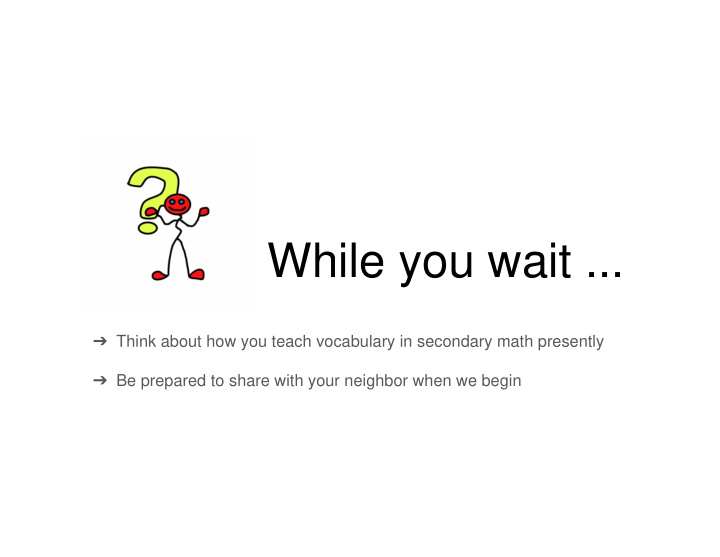



While you wait ... ➔ Think about how you teach vocabulary in secondary math presently ➔ Be prepared to share with your neighbor when we begin
Talk it Out Improving Achievement for Students with Disabilities by Teaching Vocabulary Stefan Mygas, GCPS Curriculum Specialist, stefan.mygas@gc.k12.va.us Mary Runnells ~ GCPS Special Education Instructional Specialist ~ mary.runnells@gc.k12.va.us
Why teach vocabulary and discourse in secondary math? ➔ Increases student engagement ➔ Improves conceptual understanding ➔ Provides foundational knowledge for next level learning ◆ Virginia Standards of Learning ◆ Profile of a Virginia Graduate ◆ NCTM Principles and Teaching Practices
Gloucester High School
Gloucester High School
Algebra I SOL Practice Item
Four step process 1. Identify key vocabulary 2. Explicitly teach vocabulary 3. Practice using vocabulary 4. Assess for understanding
Identify Key Vocabulary Keep it limited - quality over quantity Where?? VDOE MIPs • VDOE Word Wall cards • Textbook lists • Local curriculum guides •
Identify Key Vocabulary May need to pre-assess knowledge and teach vocab from earlier grades
Explicitly teach vocabulary Small group or whole group? • Tools for organizing • Consistent routines and practices help •
Frayer Model
Term Definition Example(s) 2 + 4 = 6 Sum the result of adding two or more numbers 2 + 8 + 3 = 13 Difference the result of subtracting one number from another 8 - 3 = 5 6 is the product Product the result of multiplying numbers of 2 and 3 3 x 2 = 6 2 x 3 = 6 12 ÷ 3 = 4 Quotient the answer after we divide one number by another ⇱ quot i ent - -4 i s t he quot i ent ( a ns w er ) a f t er w e di vi de 12 by 3 12 + 4 = 16 Operation ⇱ oper a t i on i s a ddi t i on a mathematical process – 3 ∙ 6 = 18 add, subtract, multiply, divide - ⇱ oper a t i on i s m ul t i pl i ca t i on used to separate expressions
Practice Incorporate and use vocabulary in all lessons and activities Be sure students have a chance to use the language • Monitor student use of vocabulary • Use positive, corrective feedback •
Practice Vocab-specific practice: Sorts, flashcards, games, etc. Independent, partner, small groups, whole class • Monitor and provide guidance as needed • Independent practice only when a high level of success • demonstrated
Practice (Smith & Stein, 2018) 1. Anticipate likely student responses, 2. Monitor student thinking while they work on the task, 3. Select particular students to present their work to the whole class, 4. Sequence student responses that will be displayed, and 5. Connect responses
Assess Assessing vocab specifically makes sure that it is taught and learned, not assumed or left to chance. Vocab-specific quizzes • Vocab questions on quizzes/tests • Classwork and informal assessments •
Planning Think about the equations standards for your content/grade level. Using the resources provided, how could you: Identify key vocabulary • Create definitions • Provide examples • Develop a vocabulary sort • Assess •
References Biemiller, A. (2010) Words worth teaching: closing the vocabulary gap. The McGraw Hill Companies, Inc. Hughes, C. C. & Riccomini, P. J. (2019). Purposeful independent practice procedures: An introduction to the special issue. TEACHING Exceptional Children.Vol. 51, No. 6, pp 405-408. DOI: 10.1177/0040059919850067 Morano, S. (2019). Retrieval practice for retention and transfer. TEACHING Exceptional Children.Vol. 51, No. 6, pp 436-444. DOI: 10.1177/0040059919847210 Powell, S. R., Stevens, E. A., & Hughes, E. M. (2018). Math language in middle school: Be more specific. TEACHING Exceptional Children, Vol. 51 No. 4, pp. 286-295. DOI: 1177/0040059918808762 Smith, M.S., and Stein, M.K. (2018). 5 Practices for Orchestrating Productive Mathematics Discussions (2nd Ed,) Reston, VA: National Council of Teachers of Mathematics. Steele, M.D. (2019). Tools for facilitating meaningful mathematics discourse. Mathematics Teaching in the Middle School, Vol. 24, No. 6, p. 354-361.
Recommend
More recommend